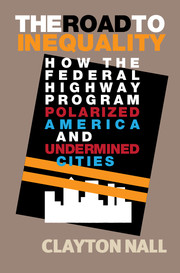Book contents
- Frontmatter
- Dedication
- Contents
- List of Figures
- List of Tables
- Guide to Abbreviations
- Acknowledgements
- 1 Introduction
- 2 How Highways Facilitate Partisan Geographic Sorting
- 3 Highways Polarize Metropolitan Political Geography
- 4 Transportation Becomes a Partisan Issue
- 5 Implications for Transportation Policy Making
- 6 Conclusion
- Bibliography
- Index
3 - Highways Polarize Metropolitan Political Geography
Published online by Cambridge University Press: 19 March 2018
- Frontmatter
- Dedication
- Contents
- List of Figures
- List of Tables
- Guide to Abbreviations
- Acknowledgements
- 1 Introduction
- 2 How Highways Facilitate Partisan Geographic Sorting
- 3 Highways Polarize Metropolitan Political Geography
- 4 Transportation Becomes a Partisan Issue
- 5 Implications for Transportation Policy Making
- 6 Conclusion
- Bibliography
- Index
Summary
As Chapter 2 demonstrated, partisans have differed in their community preferences, and transportation infrastructure enables them to act accordingly. In this chapter, I demonstrate how the Interstate Highway System, specifically, has changed the political makeup of metropolitan areas since the 1950s. By facilitating suburban growth and migration, highways have enabled suburban Republican growth, especially in fast-growing counties concentrated in the South and the Sun Belt. Because of the Interstate Highway System, the central and peripheral counties of metropolitan areas have become more polarized from each other than they would have been otherwise.
The Interstate Highway System offers an ideal case study for examining transportation infrastructure's effects on political geography. First, it was large in scope (41,000 miles in length, as originally planned), and most of this mileage was built in the first decade or so after passage of the Federal Aid Highway Act of 1956. Second, the Interstate Highway System was a preplanned and plausibly exogenous intervention: while state governments had discretion over localized details of highway routing, unlike previous legislation, the Federal Aid Highway Act of 1956 funded a single, nationwide highway network. State highway engineers, often operating strategically to satisfy the preferences of state and federal officials, nominally relied upon documented criteria when determining where to locate roads (Seely, 1987). While meddling by elected officials may sometimes explain the rules under which highways were placed in some counties and places and not others (the “assignment mechanism”) (Rubin, 1991), this process can be reconstructed for Interstates far more easily than for many other types of policy interventions.
The widely publicized factors used in planning the Interstate Highway System facilitated an estimation strategy employing nonparametric matching and regression to identify Interstate highways’ effects. Much of my attention in this chapter focuses on the factors leading to Interstate placement in one place versus another. Unlike other highway programs, a single Interstate plan was adopted in broad outline before construction, enabling present-day researchers to identify and then account for the factors driving nonrandom highway placement. Key planning criteria to be used in the locations of a national expressway network appear in the 1944 Interregional Highways report, which laid out an early version of what would become the Interstate Highway System (United States, Public Roads Administration, 1944).
- Type
- Chapter
- Information
- The Road to InequalityHow the Federal Highway Program Polarized America and Undermined Cities, pp. 51 - 69Publisher: Cambridge University PressPrint publication year: 2018



